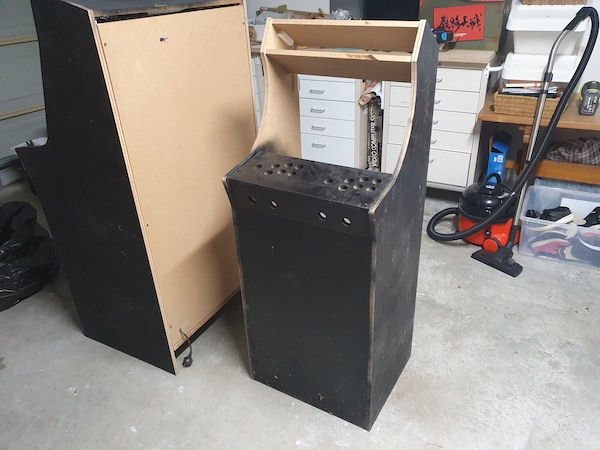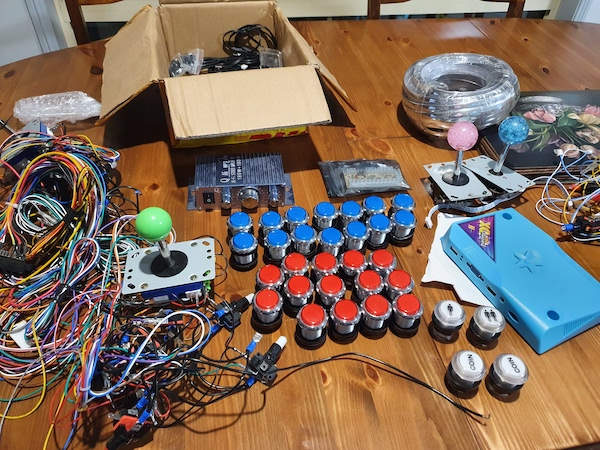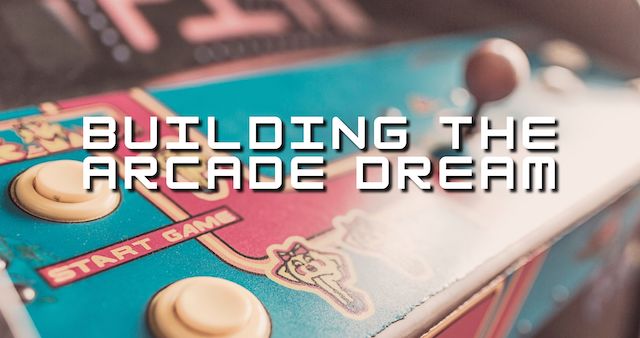Building the Arcade Dream, Part 1
Growing up in the 80’s gave the Arcade Machine a special place in my heart. While I wasnt ever able to fervently feed all my money into them I knew my way around. There was a time when you could stumble across a cabinet literally anywhere, from the local greasy spoon cafe to the common room at college. It was the best of times, etc. Even school swimming lessons would see us running across the road at the last minute after crowding a dark back room in a takeout. Shouting out ‘dibs’ on your mate’s last man in Frogger.
No trip to the UK seaside would ever be the same once the Arcade owners took hold, and for a good long while the industry boomed. Then it got commercial, consoles started chipping away at the popularity and gamers stayed indoors more.
All well and good, personally I saw the potential, even at school I wanted to run an arcade. Of course selling overpriced cokes to schoolmates on a trip to France wasn’t going to get me there. Like many pipe dreams it fell by the wayside and got lost in life as we know it.
Life, Goals, Dreams and in Betweens.
There was always the urge, the yearning to have a cabinet of my own, but landing on a favourite game was nigh on impossible. For a long time I dallied with the MAME option, saving an old PC then building a box for it. The more I looked, the more it seemed like a bridge too far for me. I left PC gaming a long time ago because back then it was a pain in the arse.
Setting up MAME and a rig was out for me, even now in my fifties I really couldn’t be bothered. Every now and again I’d think about converting an old console, I even got as far as soft modding an OG Xbox, but I didn’t like the interface and playing SNES games on an Xbox wasn’t what I wanted.

Last year mid pandemic panic I started looking around again and guess what. The world has moved on, our dear friends in faraway places have packaged emulators and the old 60-in-1 jamma rigs have mutated. Now it’s the age of the Pandora Box, and if you get one with less than 3,000 classic games – you’re doing it wrong.
There’s still a bit of research to do, especially if like me you want to build it rather than buy a pre-done cabinet. However, the process is a lot more attractive and if I can get a Pandora Jamma cabinet running, I might even have a play with a Raspberry Pi…
Fast forward to 2021.
The previous twelve months had not been kind. COVID19, yes that was a thing, but on the back of it Halloween 2020 brought a monstrous Hailstorm to my neighbourhood that all but destroyed my house. I’d never seen hail the size of cricket balls before, let alone be driving through it and live to tell the tale.
I brought this up, because it gave New Year 2021 a focus and I promised myself a few things. Publish another book (which I did), build a UCS LEGO Millenium Falcon and finally sort out my own Arcade Cabinet.
I had been on the lookout for the first few months of the year, and then it came. While out of our house for 3 months of repairs I started getting serious. I signed up to www.thegeekpub.com and bought their layout plans for building a cabinet. It was useful, but not the design I wanted. I spent time trawling the web, PInterest, Instagram and Google all providing inspiration.
Let’s be honest, I’m not the handiest of handymen, I can hold my own, but there are people in my life that refuse to let me damage the house. However, moving back into a repaired home I could see a future with a tidy Garage and a well stocked Arcade Cabinet.
There were decisions to make early on, full size vs. Bartop, I really don’t like the Bartop approach. Then there was the fight over Marine Ply or MDF as the base material. I love the smell and feel of the Ply, but trying to buy it fairly in Australia felt like too much of an investment.
Lucky Me in the Lucky Country.
Of course I was constantly on the lookout for dilapidated cabinets that needed love, but there are professionals out there that will snipe you before you know you’ve been snipen to. Inevitably this leads you down the Facebook Marketplace path, both a blessing and a curse.
This time there was treasure at the end of the rainbow, about six weeks before moving back in I found a listing. It was somebody’s unfinished project, a cabinet in MDF, mostly built and half wired. The bonus was that it came with a 2020 Pandora Box, plenty of buttons and joysticks.

To be honest I ended up paying less than the cost of the internals. The deal also got me not one, but two cabinets to boot. Both cabinets do not fit the profile I prefer, they are more like Laurel and Hardy variants of the Lowboy Arcade Cabinet. That said, they were perfect for me to practice on. Maybe I should cut my teeth on one for the kids, then get the other really nice for me. Maybe I should get one done and sell it to finance a decent build, maybe both?
Either way, after spending 6 weeks in the back of my van finally moving home meant they got relegated to the back of the garage while work and unpacking took over.
Until now.
Decision made, project locked in.
A couple of months later I finally had the chance to really look at the cabinets. The Fat One will be a better long term prospect, I think I can get a 32” Screen in there. The Thin One is almost child size, but still nice and compact. It’ll take a 19” LCD, but the only one I have right now is VGA.
The key factor for me in going with the Thin One first up is the build quality. I bought the cabinets half-built from patterns the seller had bought pre-cut. The Fat One is full of gaps and not square. It was either put together on a bad day or is a really bad cut. By comparison the Thin One is square and tightly put together, that saves me some handyman heartache up front. It will probably be too short for me, but the kids will love it and I’m sure I can hunch over it while I smash them at Streetfighter II Turbo.

This is part one of a series. I’ve made my decision to go with the path of least resistance, in the next instalment I will share a wealth of useful resources I’ve been finding to make sense of the process. Along with some updates on the build itself.
For now, join me in wistful yearning to be able to play The Speed Rumbler again.





